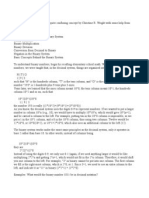CS Conversion Notes
Uploaded by
Hein Thant AungCS Conversion Notes
Uploaded by
Hein Thant AungCS Conversion notes
Wednesday, July 5, 2023 8:35 PM
Binary ---> Denary ► Subtraction
This method subtracts the given number with the less
Binary is a base 2 number system binary number (2 powers number ex: 2, 4, 8) till it reached
0.
128 64 32 16 8 4 2 1
2^7 2^6 2^5 2^4 2^3 2^2 2^1 2^0 Ex: 49
First we will have to know our 2 powers
To covert to Denary 128 64 32 16 8 4 2 1
Denary has a base 10 number system which allow humans to
understand. Subtract the number that are lower than 152
152 - 128 = 24
• Two methods 24 - 16 = 8 24 is less than 64 and 32 so we use 16
► Division [assumed to be easier]
16 - 8 = 8
This method divides the given number with 2 until it has reached 0.
8 - 8 = 0 If numbers were equal, allowed to subtract
Ex: 49 By dividing 49 with 2
2 | 49 It leaves a reminder 1 From there put 1 in the number we had used and 0 which
2 | 24 R -> 1 ^ It continues to divide till it was 2 x 0 weren't
2 | 12 R -> 0 | The answer is written down to upwards 128 64 32 16 8 4 2 1
2 | 6 R -> 0 | 49 = 0 1 1 0 0 0 1 (7 bits) 1 0 0 1 1 0 0 0
2 | 3 R -> 0 | 152 = 10011000
2 | 1 R -> 1 | To note:
0 R -> 1 | Bits usually represent in 8 bits numbers
--------------> added extra --->0 0 1 1 0 0 0 1 (8 bits)
Denary ----> Binary
Binary Adding
To add binary numbers: To convert you will need 2 powers number to add 1s that were used.
• 0+1=1 1 = on 0 = off
• 1 + 1 = 1 0 [ 2^1 = 2 in binary 1 0] 2 powers --> 128 64 32 16 8 4 2 1
• 1 + 1 + 1 = 1 1 1 [in binary 1 1 = 3]
Ex: 0 1 1 1 1 0 0 1
128 64 32 16 8 4 2 1
Ex: 0 1 1 1 1 0 0 1
1 1 1 1 <carry numbers
1 0 0 1 1 0 1 0 1) Write down the 2 powers numbers
+1 1 0 1 0 1 1 1 2) Add numbers which were put to one.
1 0 1 1 1 0 0 0 1 <answer 64 + 32 + 16+ 8 + 1 = 121
^over flow
0 1 1 1 1 0 0 1 = 121
Binary ---> Hexadecimal
Hexadecimal is base 16 number system that makes binary number shorter and easier
to read.
It goes 0 1 2 3 4 5 6 7 8 9 A B C D E F {in total of 16 number usage}
A = 10 B = 11 C = 12 D = 13 E = 14 F = 15
Ex: 1 1 1 0 0 1 1 0
To convert hexa you will need to put the binary number in a group of 4
1 1 1 0 = 15 [ E ]
0110= 6
1) Just like in denary you will switch binary to denary number
2) It will be re-written in order
1110/0110
E 6
11100110=E6
CS Page 1
You might also like
- Lec 1 - Number Systems and Digital LogicNo ratings yetLec 1 - Number Systems and Digital Logic38 pages
- Chapter 8 Introduction To Binary NumbersNo ratings yetChapter 8 Introduction To Binary Numbers18 pages
- DCN 157 - Introduction To IT (Lecture 3)No ratings yetDCN 157 - Introduction To IT (Lecture 3)31 pages
- Binary Code: How To Calculate Numerical BinaryNo ratings yetBinary Code: How To Calculate Numerical Binary7 pages
- Caie Igcse Computer Science 0478 Theory 660982a473c35727dc3c585f 895No ratings yetCaie Igcse Computer Science 0478 Theory 660982a473c35727dc3c585f 8957 pages
- Digital Electronics: Instructional ObjectivesNo ratings yetDigital Electronics: Instructional Objectives35 pages
- 1 CSC 205 Chapt 1 to 2 Digital & HardwareNo ratings yet1 CSC 205 Chapt 1 to 2 Digital & Hardware19 pages
- Caie Igcse Computer Science 0478 Theory 66544355e686c60de794fa98 643No ratings yetCaie Igcse Computer Science 0478 Theory 66544355e686c60de794fa98 64322 pages
- Caie Igcse Computer Science 0478 Theory 67008c291aa84025c60c2fd5 391No ratings yetCaie Igcse Computer Science 0478 Theory 67008c291aa84025c60c2fd5 39122 pages
- 02-Data Representation in The Computer SystemsNo ratings yet02-Data Representation in The Computer Systems42 pages
- caie-igcse-computer-science-0478-theory-64f3df11846b4a034ab6a8a0-023No ratings yetcaie-igcse-computer-science-0478-theory-64f3df11846b4a034ab6a8a0-02322 pages
- Data - RepresentationPart 2 File Organization L1&2No ratings yetData - RepresentationPart 2 File Organization L1&229 pages
- Caie Igcse Computer Science 0478 Theory Fsjnbwwaw9cbgewry 539No ratings yetCaie Igcse Computer Science 0478 Theory Fsjnbwwaw9cbgewry 53922 pages
- Cambridge Igcse Computer Science Study and Revision Guide Sample Pages 9781398318489No ratings yetCambridge Igcse Computer Science Study and Revision Guide Sample Pages 978139831848923 pages
- caie-igcse-computer-science-0478-theory-6713c660334c102d03b640dd-977No ratings yetcaie-igcse-computer-science-0478-theory-6713c660334c102d03b640dd-9779 pages
- A'Level_Computer_Science_by_Zafar_Ali_KhanNo ratings yetA'Level_Computer_Science_by_Zafar_Ali_Khan172 pages
- caie-igcse-computer-science-0478-theory-669f9858d0d059256875875e-519No ratings yetcaie-igcse-computer-science-0478-theory-669f9858d0d059256875875e-51922 pages
- Chapter-1 Data Representation (Computer Science)No ratings yetChapter-1 Data Representation (Computer Science)170 pages
- Mark Scheme (Results) January 2019: Pearson Edexcel International GCSE in Further Pure Mathematics (4PM0) Paper 01No ratings yetMark Scheme (Results) January 2019: Pearson Edexcel International GCSE in Further Pure Mathematics (4PM0) Paper 0126 pages
- Mark Scheme (Results) Summer 2019: Pearson Edexcel International GCSE in Further Pure Mathematics (4PM1) Paper 02RNo ratings yetMark Scheme (Results) Summer 2019: Pearson Edexcel International GCSE in Further Pure Mathematics (4PM1) Paper 02R24 pages
































































